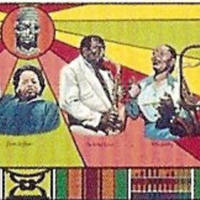
Baltimore Wall of Pride
The Baltimore Wall of Pride stands in the playground at Carey and Cumberland streets in the area of Sandtown-Winchester, Baltimore, Maryland. Painted in 1992 soon after the Rodney King riots of LA, the mural became a site for protest meetings after Freddie Gray was killed in 2015, just blocks away from the mural.Painted by Pontella and Deborah Mason, the mural celebrates the heroes of black history, including Fannie Lou Hamer, James Baldwin, Marcus Garvey, Martin Luther King Jr., Kwame Nkrumah, Charlie Parker, John Coltrane, Langston Hughes, and the antislavery figures Frederick Douglass, Sojourner Truth and Harriet Tubman.
![Nelson Stevens, Centennial Vision, Tuskegee University Administration Building, AL, 1980 [destroyed].jpg.gif Nelson Stevens, Centennial Vision, Tuskegee University Administration Building, AL, 1980 [destroyed].jpg.gif](https://486312.frmmmguz.asia/files/square_thumbnails/1a0ef8af8ec25559e5c2c7c66502ba40.jpg)
Centennial Vision
In 1980, on the anniversary of the founding of the Tuskegee Institute, AfriCOBRA member Nelson Stevens created a mural to celebrate the occasion. Although Stevens was commonly an exterior mural painter, he created this mural on the inside of the Tuskegee University Administration Building. The mural contains the images of black history figures such as Booker T. Washington (former president of Tuskegee University), General Chappie James and the Tuskegee airmen of World War II, Cinque, Malcolm X, Martin Luther King Jr., and George Washington Carver, as well as the antislavery figures Harriet Tubman, Sojourner Truth and Frederick Douglass. Also included in the image is a phrase made famous by the African scholar John S. Mbiti, “I Am Because We Are.” This mural no longer exists.
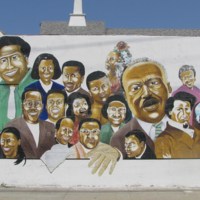
Wings of Faith
In 2005, an anonymous artist painted a mural in Los Angeles that depicted many heroes of African American history. The faces of antislavery leaders Sojourner Truth and Frederick Douglass, alongside Muhammad Ali, Martin Luther King Jr., Malcolm X and Rosa Parks, lined the street. By 2015, the building had fallen into disrepair and the mural had been destroyed.
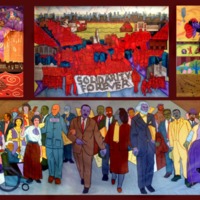
The City at the Crossroads of History
In 2011, the Puffin Foundation commissioned Mike Alewitz to paint a mural for the Puffin Gallery of Social Activism that would be on display in the Museum of the City of New York. Completed in 2014, the mural is a tribute to the labour and social justice movements and contains four panels. It includes slave ships and depicts the antislavery leader Frederick Douglass, as well as Martin Luther King Jr., Coretta Scott King and Elizabeth Gurley Flynn.However after viewing the mural, the museum declined to display it. They requested changes that reduced the prominence of Martin Luther King Jr. and added the Women’s Christian Temperance Union. Alewitz calls this a case of censorship and continues to campaign for his mural to be displayed.
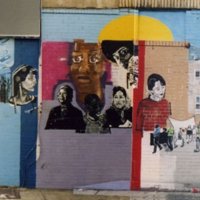
Women Warriors
In 2001, Brooklyn-based muralist Leola Bermanzohn created a mural in the Flatbush area of Brooklyn titled Women Warriors. Bermanzohn works as a muralist for the Groundswell organisation, launched in 1996 with the mission of bringing together artists, youth and community organisations to create murals that beautify local neighbourhoods and give expression to underrepresented ideas and perspectives. Women Warriors was created in collaboration with Sister Outsider – an organisation run by and for women of colour that aimed to help women enter the professional world of work and operate in the political realm. The mural was at the organisation’s headquarters and depicted antislavery leaders Harriet Tubman and Sojourner Truth as well as Nefertiti, Rosa Parks and Assata Shakur, alongside a poem written by Audre Lorde. It had been destroyed by 2015.
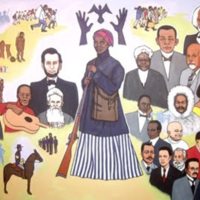
From Africa to America
Wilfred R. Stroud created this seven-panel mural in 1988 to be installed on the first floor of the Tubman Museum. It remains a signature piece in the Museum’s collection today. When the mural was being created, Stroud expained: “The purpose of this mural is to present a visual history of the black man and woman from the earliest times in Africa to the present times in America. The panels focus attention upon the impact of outstanding persons, and events that made a change in the lives and conditions of black people in particular, and the world in general.” Stroud dedicated an entire panel to the topic of slavery. Harriet Tubman stands in the centre, holding a rifle and surrounded by other antislavery leaders: Sojourner Truth, Abraham Lincoln, Frederick Douglass and John Brown.
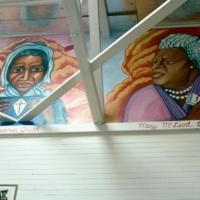
The Great Cloud of Witnesses
In 1992, Selma Brown, Susan Cervantes and Ronnie Goodman painted images of the antislavery leaderes Sojourner Truth, Harriet Tubman and Frederick Douglass, as well as Mary McLeod Bethune, W.E.B. Du Bois, and Thurgood Marshall, at Ingleside Presbyterian Church and Community Center in San Francisco, California. The mural, titled The Great Cloud of Witnesses, was started by Revered G. when he pasted a single newspaper clipping of his hero, Muhammad Ali to the wall of the church gymnasium in 1980. Over the decades, the collage expanded to cover the entire gym, fellowship hall, stairways, hallways, bathrooms, basement and meeting rooms. The mural is multi-faceted and contains newspapers, magazine clippings, photographs, flyers, posters, prints, poetry and painted murals.
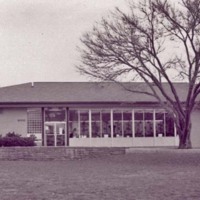
Odom Branch Library Mural
Woodrow Nash created a mural for the Odom Branch Library in the 1970s, depicting the antislavery leader Frederick Douglass alongside Martin Luther King Jr. and Malcolm X. In 1999, the library was remodelled and expanded to around 12,000 square feet. With the expansion came two new murals about black history. The original mural was edited – this time to incorporate the antslavery leader Sojourner Truth. By adding Truth to the mural, Nash was trying to reflect the contribution of women to the liberation struggle.
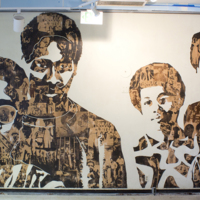
The Black Experience
In 1970, a group of seven black UCLA art students created a mural titled The Black Experience on the first floor of the Ackerman Student Union building. The mural, which measures 10 feet by 27 feet, was obscured for 20 years by a false wall erected in front of it during building renovations in 1992. Then in 2013, the mural was restored. “It was important in 1970, as it is today, to address issues of racial disparity on the UCLA campus,” one of the artists, Helen Singleton said. “Our mission in creating ‘The Black Experience’ mural was to expand and enhance that effort with a visual representation of the history and experience of African Americans in the United States.” The seven art students, Helen Singleton, Marian Brown, Neville Garrick, Andrea Hill, Jane Staulz, Joanne Stewart and Michael Taylor, are all depicted in the mural, alongside silk-screened graphics of the antislavery leaders Frederick Douglass and Harriet Tubman, alongside Martin Luther King Jr., Malcolm X, Bobby Seale, Huey P. Newton, Muhammad Ali, and Angela Davis. “We learned a lot about our history by exploring what images to use,” said Garrick, who was a freshman from Jamaica when he participated in the art project. In 2012, the effort to uncover the mural gained momentum after members of the Afrikan Student Union brought the mural to the attention of the Associated Students UCLA board of directors. At the unveiling in 2013, both Singleton and Garrick were guests of honour, along with activist Angela Davis.
![Leroy White, Wall of Respect, Up You Mighty Race, Leffingwell & Franklin Aves, St. Louis MO, 1968 [destroyed 1980s].jpg Leroy White, Wall of Respect, Up You Mighty Race, Leffingwell & Franklin Aves, St. Louis MO, 1968 [destroyed 1980s].jpg](https://486312.frmmmguz.asia/files/square_thumbnails/ccbe25581b885dd6ea7ad25405af90fe.jpg)
Wall of Respect/Up You Mighty Race
In 1968, after the success of Chicago’s Wall of Respect in 1967, muralist Leroy White painted Wall of Respect/Up You Mighty Race in St. Louis, Missouri. The mural was self-sponsored. After seeing Chicago’s Wall of Respect in Ebony, muralists in St. Louis were inspired to create public art in the Carr Square area of the city. The mural was completed by a coalition of individuals from civil rights groups, including CORE, ACTION, and the Zulu 1200s. It displayed a pantheon of black heroes, including the antislavery leaders Frederick Douglass, Malcolm X, Martin Luther King Jr., and Marcus Garvey. The mural quickly became a hub of black activism—bringing together artists, performers and political figures in a series of concerts and rallies at the site. But it was vandalised during the 1970s, and its building was razed in the 1980s.
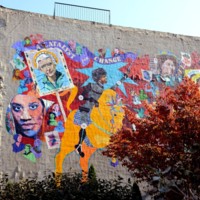
When Women Pursue Justice
In 2005, Artmakers Inc. created a large-scale political mural titled When Women Pursue Justice. During the genesis of the mural, it seemed like an overly ambitious project with little funding, and a heavy reliance on the generosity of its collaborators. Located in Brooklyn, at the busy intersection between Nostrand and Greene Avenue, the mural is populated with women who worked towards justice and social change over the last 150 years. The most visually noticeable figure on the mural is the thirty-five-foot image of Shirley Chisholm astride a golden horse and dressed in armour of African mud and kente cloth. Surrounding Chisholm are 90 women who risked their lives and liberty to achieve voting rights, civil rights, racial justice, health and reproductive rights, and environmental justice and protection – including the abolitionists Harriet Tubman and Sojourner Truth, as well as Angela Davis, Wilma Mankiller, Margaret Sanger, and Dorothy Day.
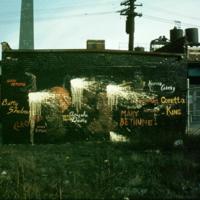
Racism
In 1970, a mural titled Racism appeared in the Cabrini-Green Housing Projects in Chicago’s southside. It celebrated black women who had been key participants in the struggle for black liberation. The mural depicted the faces of Nina Simone, Angela Davis and Kathleen Cleaver, along with the names of Aunt Jemima, Betty Shabazz, Cleopatra, Mary McLeod Bethune, Coretta Scott King and the abolitionist Sojourner Truth. The mural was defaced with white paint shortly after its completion.
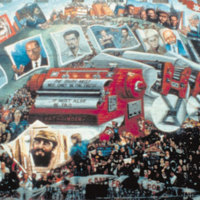
Pathfinder Mural
In 1988, Mike Alewitz designed and began to direct the creation of Pathfinder Mural in New York City’s West Village. The mural, measuring 79 x 85 feet, was an international collaboration of 80 artists from 20 different countries including Argentina, Canada, Iran, New Zealand, Nicaragua and South Africa. At its dedication, it was hailed as one of the largest political murals in the world. In 1987, Alewitz had approached the leaders of the Socialist Workers Party (SWP), of which he was a member, and proposed that Pathfinder Press sponsored a mural for its Charles Street building. The party approved both the project and his concept of the mural: a celebration of the revolutionary struggles in Cuba, Grenada, Nicaragua and South Africa, as well as in America. The central image of the mural is a large red printing press. The faces of Fidel Castro, Che Guevara, Malcolm X, Karl Marx, and Nelson Mandela loop around it. The abolitionists Frederick Douglass, Harriet Tubman and Sojourner Truth also feature. During the creation of Pathfinder Mural, the National Endowment for the Arts withdrew funding from several controversial projects, prompting a debate on free speech and censorship. For the first few months of this mural's creation, work continued without incident. But in 1989, Patrick Buchanan, a conservative commentator, vilified the mural in the Washington Times, calling it a “six-story shrine to communism, a Marxist Mount Rushmore in Greenwich Village." As the mural neared completion, the dialogue between Alewitz and the SWP started to break down. Alewitz was blocked from attending the mural dedication ceremony on November 19, 1989. During December, vandals threw glass bottles filled with white paint at the mural. In 1996, the mural was removed in order to repair cracks in exterior wall of the Pathfinder building, and by 2003, the building on which Pathfinder Mural was housed was sold for around $20 million.
![Wardell McClain, Sim's Corner Wall of Respect, 618 E 47th St at South Champlain Ave. [Black Neighborhood], Chicago, 2009.jpg Wardell McClain, Sim's Corner Wall of Respect, 618 E 47th St at South Champlain Ave. [Black Neighborhood], Chicago, 2009.jpg](https://486312.frmmmguz.asia/files/square_thumbnails/1018bd0dce61a7264d61cd9907fc7cfe.jpg)
Sim's Corner Wall of Respect
In 2009, Wardell McClain created a mural on South Champlain Avenue in Chicago, Illinois titled Sim's Corner Wall of Respect, that took its inspiration from the 1967 mural, Wall of Respect. It includes the faces of the abolitonists Frederick Douglass, Harriet Tubman, and Sojourner Truth as well as Martin Luther King Jr., Jesse Jackson, Malcolm X, Harold Washington, Elijah Muhammad, Nelson Mandela, Michael Jordan, Coretta Scott King, Marcus Garvey and Booker T. Washington.
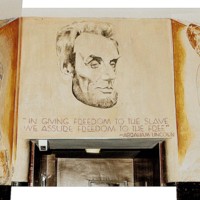
Seward Park Mural
In 1959 the Hungarian-American illustrator and muralist Hugo Gellert created the series Seward Park Housing Murals. The four-panel mural series depicts Thomas Jefferson, Abraham Lincoln, Franklin D. Roosevelt and Albert Einstein and was commissioned by the International Ladies Garment Workers Union. The Abraham Lincoln panel has an abolitionist section that features Frederick Douglass, John Brown, Harriet Tubman, Sojourner Truth and William Lloyd Garrison.The mural was threatened with destruction many times, including in 1996 when the building residents voted to become a private co-op. Individuals on the co-op board then voted to rid the lobby of the murals that they deemed racist, ugly, socialist or 'past their time.' But the building manager, Frank Durant, insisted on their preservation.
![Eugene 'Edaw' Wade, Cramton Auditorium Mural, Howard University, 1976 [destroyed].jpg Eugene 'Edaw' Wade, Cramton Auditorium Mural, Howard University, 1976 [destroyed].jpg](https://486312.frmmmguz.asia/files/square_thumbnails/9b88d25ab0cf2bbdaa447fb07c56eee8.jpg)
Cramton Auditorium Mural
In 1976, Eugene Eda Wade created a mural at Howard University in Washington D.C. The mural depicts the abolitionists Sojourner Truth and Nathaniel Turner attempting to break chains, as well as the abolitionists Frederick Douglass and Harriet Tubman, and leaders Malcolm X and Martin Luther King Jr. The mural has now been destroyed.